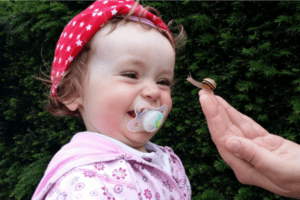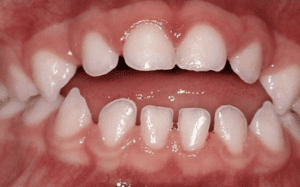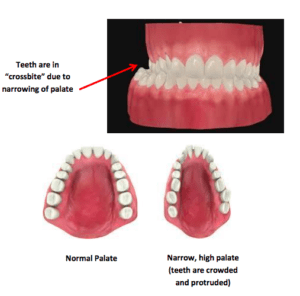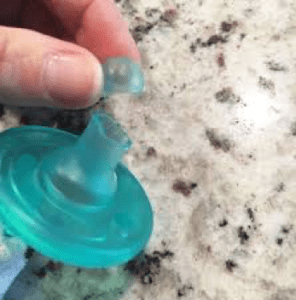Disclaimer:: This post is sponsored by our friends at Lafayette Pediatric Dentistry and authored by Pediatric Dentist, Dr. Anita Gouri.
When is it time to take away my baby’s pacifier?
One of the most popular dental FAQ’s by parents of toddlers: When do I have to get rid of my child’s pacifier?
The answer: before it starts to affect the development of their jaws and bite. So what age do these changes start to happen? There is no one answer, because children develop at different rates. As a general rule however, we pediatric dentists prefer to see a pacifier used only for falling asleep by age 1, and discontinued by age 2. By 2 years old, many children have a strong chance of developing a “malocclusion,” where teeth do not properly align, due to prolonged pacifier sucking. Malocclusions can lead to speech difficulties, tongue-thrust patterns, and significant orthodontic crowding.
 Additionally, the pacifier can “push” the upper front teeth forward, so that they protrude beyond normal limits. This can make the upper front teeth very prone to injury.
Additionally, the pacifier can “push” the upper front teeth forward, so that they protrude beyond normal limits. This can make the upper front teeth very prone to injury.
Sometimes, especially if a child gets most of their baby teeth by 15 months of age, these adverse dental and skeletal changes can be much more pronounced. For this reason, it is extremely important that your child already have a dental home established no later than age 1, as recommended by both the American Academy of Pediatrics and Pediatric Dentistry. This would ensure their facial/dental growth and development is monitored closely.
What does a malocclusion look like?
There are many forms. Prolonged placement of any object between the teeth, most commonly a finger/thumb or pacifier, can cause an “open bite,” where the front teeth cannot touch each other or overlap when the child is biting down. Here is an example:
Additionally, prolonged habitual sucking can gradually cause a narrowing of the palate. The cheek muscles are always contracting during  sucking, steadily exerting an inward force on the mouth. This inward force decreases the overall width of the oral cavity, leading to narrow jaws. Narrow jaws can lead to severe orthodontic crowding, crossbites, narrow airway, and chronic mouth breathing.
sucking, steadily exerting an inward force on the mouth. This inward force decreases the overall width of the oral cavity, leading to narrow jaws. Narrow jaws can lead to severe orthodontic crowding, crossbites, narrow airway, and chronic mouth breathing.
What is the best way to get rid of a pacifier?
Cold turkey. Believe it or not, weaning is not as effective, as it only teaches a child to cry longer for a pacifier. At the age of 2 years, we believe the “out of sight, out of mind” approach is more effective. Cognitively, your two year old is also just mature enough to understand that she is a “big girl” and doesn’t need her binky because “binkies are for babies, and not big girls.” You can make a big production out of leaving the pacifier for the “pacifier fairy,” or for a new baby in your social circle. I’ve had parents credit Mickey Mouse with successful pacifier quitting after a trip to Disney World! Lay it on thick with the enthusiasm and reward your child with tons of praise for not using a pacifier. “Lovies” in place of a pacifier also work wonders.
I personally don’t recommend cutting the tip of the pacifier!
 I know this is an age-old method that many parents have had success with for quitting the pacifier. I personally feel, however, that “bits” of a cut pacifier can end up in the baby’s mouth and be ingested or cause a potential aspiration hazard. I have read about this happening. A lot goes into the safety protocols of a product when it was manufactured and tested to be used in its original form. I don’t believe a pacifier, or anything else that goes into a baby’s mouth, was meant to be altered or cut from its intended shape.
I know this is an age-old method that many parents have had success with for quitting the pacifier. I personally feel, however, that “bits” of a cut pacifier can end up in the baby’s mouth and be ingested or cause a potential aspiration hazard. I have read about this happening. A lot goes into the safety protocols of a product when it was manufactured and tested to be used in its original form. I don’t believe a pacifier, or anything else that goes into a baby’s mouth, was meant to be altered or cut from its intended shape.
The majority of the time, it is a little harder for your child to fall asleep without a binky, but in a matter of days, it becomes the new norm. Most parents dread saying goodbye, but once it’s done, they will tell me: “You know? It wasn’t as bad as I was expecting it to be.”
For more information about our Friends at Lafayette Pediatric Dentistry visit ::
Website | Facebook | Instagram | Twitter
About the Author
 Dr. Anita Gouri, a pediatric dentist, has been practicing in Lafayette for 10 years and is the owner of Lafayette Pediatric Dentistry. She graduated from LSU School of Dentistry in 2006, receiving honors including Outstanding Achievement in Pediatric Dentistry, Honors in Research, and the Carl A. Baldridge Academic Scholarship. She completed her residency in pediatric dentistry at Children’s National Medical Center in Washington DC in 2008 and became a board certified diplomate of the American Board of Pediatric Dentistry in 2009. In 2010, her research on dental pain assessment was published in Pediatric Dentistry. She also has specialized training in treating babies and children who have tongue and lip ties. She is a member of the Academy of Laser Dentistry, American Academy of Pediatric Dentistry, the Louisiana Dental Association, the Southwestern Society of Pediatric Dentistry, American Dental Association, as well as the C. Edmund Kells and Omicron Kappa Upsilon Dental Honor Societies. Dr. Gouri, her husband, and their two children enjoy travel, Saints football, good food and good friends.
Dr. Anita Gouri, a pediatric dentist, has been practicing in Lafayette for 10 years and is the owner of Lafayette Pediatric Dentistry. She graduated from LSU School of Dentistry in 2006, receiving honors including Outstanding Achievement in Pediatric Dentistry, Honors in Research, and the Carl A. Baldridge Academic Scholarship. She completed her residency in pediatric dentistry at Children’s National Medical Center in Washington DC in 2008 and became a board certified diplomate of the American Board of Pediatric Dentistry in 2009. In 2010, her research on dental pain assessment was published in Pediatric Dentistry. She also has specialized training in treating babies and children who have tongue and lip ties. She is a member of the Academy of Laser Dentistry, American Academy of Pediatric Dentistry, the Louisiana Dental Association, the Southwestern Society of Pediatric Dentistry, American Dental Association, as well as the C. Edmund Kells and Omicron Kappa Upsilon Dental Honor Societies. Dr. Gouri, her husband, and their two children enjoy travel, Saints football, good food and good friends.


















